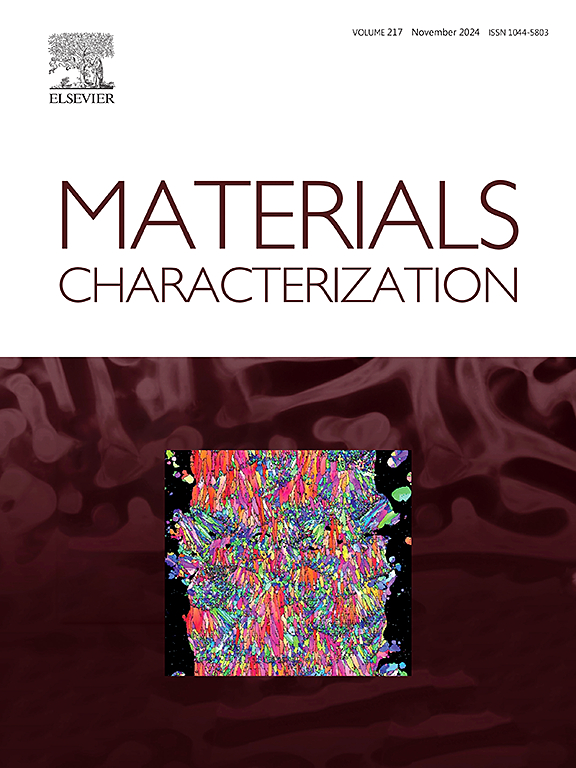深入分析了高强度Al-Zn-Mg-Cu合金厚板搅拌摩擦焊接接头的组织和力学性能
IF 5.5
2区 材料科学
Q1 MATERIALS SCIENCE, CHARACTERIZATION & TESTING
引用次数: 0
摘要
研究了搅拌摩擦焊(FSW)制备的8 mm厚Al-Zn-Mg-Cu (AZMC)合金接头在不同刀具转速(RSp、400、800、1200 rpm)和焊接速度(WSp、50、100、150 mm/min)组合以及焊后热处理(PWHT)下的组织和力学性能。焊接状态下,随着热输入的增加,熔核区晶粒尺寸和析出相尺寸均增大,分别为1.46 μm和0.27 μm ~ 2.45 μm和0.73 μm;同时,NZ的显微硬度随RSp(从400 rpm时的139.8 HV增加到1200 rpm时的152.1 HV)和WSp(从50 mm/min时的132.8 HV增加到150 mm/min时的140.2 HV)的增加而增加,这主要是由于晶界、析出和固溶强化机制之间的竞争。低、中热条件下PWHT诱导AGG异常生长,高热条件下抑制AGG异常生长;估计AGG的Zener-Hollomon阈值为4.7 × 1011 - 6.6 × 1011 s−1。在1200 (RSp) -100 (WSp)条件下,焊缝方向(WD)性能最佳(σYS = 610 MPa, σUTS = 662 MPa, δEL = 9.5%),达到母材(BM)性能的97.9%,主要是由于PWHT后超细晶粒的保留。在横向(TD)上,400 ~ 100的强度最高(σYS = 591 MPa, σUTS = 654 MPa;δEL = 10.2%, δEL = 107.4%, δEL = BM的94.0%和96.9%)。不同参数下TD的塑性变化很大程度上归因于NZ和TMAZ的均匀性和晶粒尺寸差异。这些结果突出了优化的FSW参数和PWHT对提高高强厚铝合金接头性能的关键作用。本文章由计算机程序翻译,如有差异,请以英文原文为准。
In depth analysis of microstructure and mechanical properties of joints in thick plate friction stir welding of high–strength Al–Zn–Mg–Cu alloy
This study investigated the microstructure and mechanical performance of 8 mm-thick Al–Zn–Mg–Cu (AZMC) alloy joints fabricated by friction stir welding (FSW) under various combinations of tool rotational speeds (RSp, 400, 800, 1200 rpm) and welding speeds (WSp, 50, 100, 150 mm/min), both with and without post-weld heat treatment (PWHT). In the as-welded condition, both grain size and precipitate size in the nugget zone (NZ) increased with heat input, ranging from 1.46 μm and 0.27 μm to 2.45 μm and 0.73 μm, respectively. Meanwhile, the microhardness of NZ increased with both RSp (from 139.8 HV at 400 rpm to 152.1 HV at 1200 rpm) and WSp (from 132.8 HV at 50 mm/min to 140.2 HV at 150 mm/min), primarily due to the competition between grain boundary, precipitation, and solid solution strengthening mechanisms. PWHT induced abnormal grain growth (AGG) at low and medium heat input, which was suppressed under high heat input; the estimated Zener–Hollomon threshold for AGG was 4.7 × 1011–6.6 × 1011 s−1. The 1200 (RSp)–100 (WSp) condition delivered the best weld-direction (WD) performance (σYS = 610 MPa, σUTS = 662 MPa, δEL = 9.5 %), reaching up to 97.9 % of base material (BM)’s properties, primarily due to the retention of ultrafine grains after PWHT. In the transverse direction (TD), 400–100 yielded the highest strength (σYS = 591 MPa, σUTS = 654 MPa; 94.0 % and 96.9 % of BM), while 400–150 showed the best ductility (δEL = 10.2 %, 107.4 % of BM). The plasticity variation in the TD under different parameters is largely attributed to the uniformity and grain size differences between the NZ and TMAZ. These results highlight the critical role of optimized FSW parameters and PWHT in enhancing joint performance for high-strength thick Al alloys.
求助全文
通过发布文献求助,成功后即可免费获取论文全文。
去求助
来源期刊

Materials Characterization
工程技术-材料科学:表征与测试
CiteScore
7.60
自引率
8.50%
发文量
746
审稿时长
36 days
期刊介绍:
Materials Characterization features original articles and state-of-the-art reviews on theoretical and practical aspects of the structure and behaviour of materials.
The Journal focuses on all characterization techniques, including all forms of microscopy (light, electron, acoustic, etc.,) and analysis (especially microanalysis and surface analytical techniques). Developments in both this wide range of techniques and their application to the quantification of the microstructure of materials are essential facets of the Journal.
The Journal provides the Materials Scientist/Engineer with up-to-date information on many types of materials with an underlying theme of explaining the behavior of materials using novel approaches. Materials covered by the journal include:
Metals & Alloys
Ceramics
Nanomaterials
Biomedical materials
Optical materials
Composites
Natural Materials.
 求助内容:
求助内容: 应助结果提醒方式:
应助结果提醒方式:


